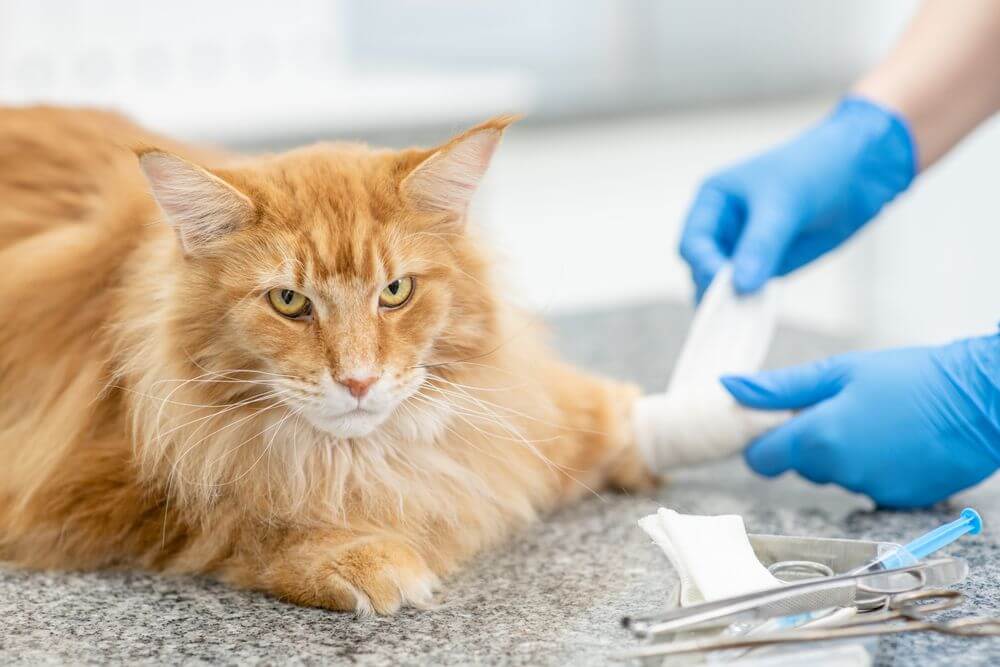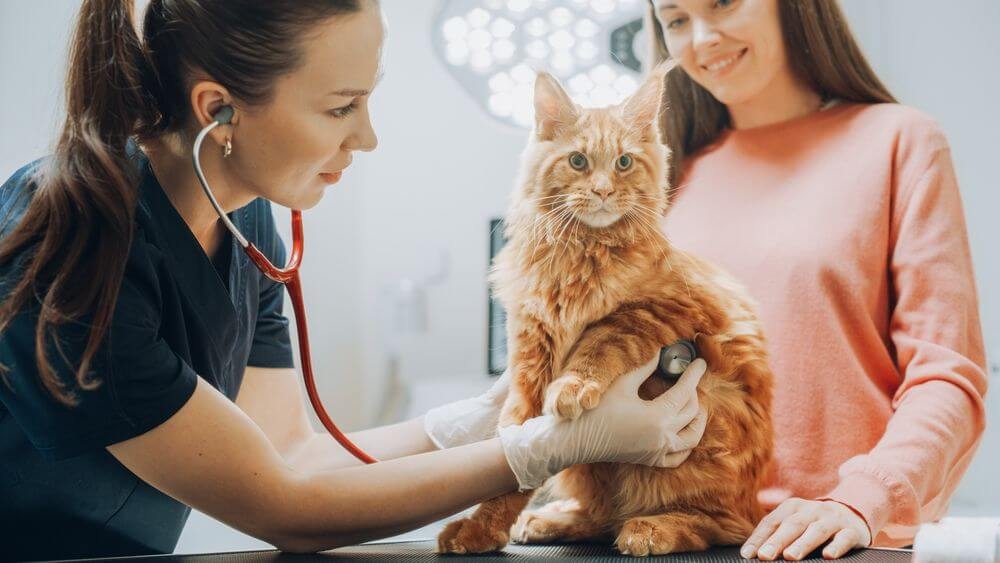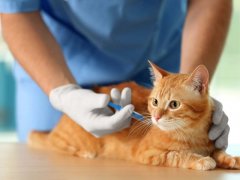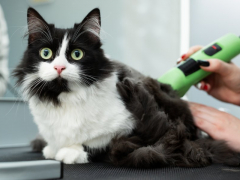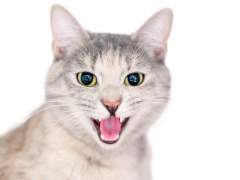Pet insurance provides an affordable way to pay for your cat’s unexpected veterinary medical care. didesign021 / Shutterstock.com
High-quality veterinary medical care is essential to keeping cats healthy, but it is becoming increasingly costly. Pet insurance plans help make vet care more affordable, giving you peace of mind from the worry of paying costly unexpected veterinary expenses.
Compared to human health insurance, pet insurance is new to the scene. You’re not alone if you’re unsure how pet insurance works and how it might benefit your cat.
Pet insurance covers accidents, illnesses, and diagnostic testing related to injury and illness. It generally does not cover well-pet expenses like vaccines and routine dental cleanings, but you can usually purchase a wellness rider to add to your accident and illness insurance policy to cover such care.
Pet insurance plans are typically not cat-specific but cover cat-specific services needed for injuries and illnesses. In this article, we’ll review the types of pet insurance plans, how pet insurance works, and how to choose a pet insurance plan for your cat.
Types of Pet Insurance
You can choose from several types of pet insurance coverage for your cat. Ermolaev Alexander / Shutterstock.com
You can choose from several types of pet insurance plans, depending on what works best for you and your cat:
Accident & Illness
Accident and illness pet insurance covers a wide array of medical services your cat will need in the event of an accident or illness.
Examples of covered accidents are listed below:
- Hit by car
- Foreign body ingestion
- Poisoning
- Lacerations
- Broken bones
Here are examples of illnesses that are covered by this type of plan:
- Ear infections
- Kidney disease
- Urinary tract infections
- Digestive issues (e.g., inflammatory bowel disease)
- Skin issues
- Allergies
- Cancer (sometimes excluded—check your plan)
Chronic kidney disease and diabetes are common health conditions in cats. Treatment for these chronic conditions would be covered by an accident and illness plan.
Accident and illness plans cover the prescription medications needed for treatment. For example, if your cat has arthritis, your insurance will cover the cost of pain medications.
According to the most recent data from the North American Pet Health Insurance Association (NAPHIA), reported in 2022, the average annual cost of accident and illness plans for cats is $387.01 ($32.25/month).
An accident and illness plan does not cover everything. Although coverage varies, accident and illness plans do not cover pre-existing conditions or routine veterinary care like annual exams, vaccines, deworming, dental cleanings, and preventive medications.
Comprehensive (Accident & Injury + Wellness)
Comprehensive pet insurance is a combination of an accident and illness plan with a wellness add-on. Sometimes called “nose to tail” insurance, comprehensive pet insurance covers routine veterinary care (well-pet care), as well as a wide array of medical services your cat will need in the event of an accident or illness, such as:
- Injuries
- Surgeries
- Accidents
- Prescriptions
- Chronic illnesses
- Common illnesses
- Medical treatments (e.g., chemotherapy)
- Laboratory testing (e.g., bloodwork and urinalysis)
- Diagnostic imaging (X-ray, CT scans, MRI)
Accident Only
Accident-only pet insurance plans cover injuries caused by accidents. It does not cover illnesses or routine veterinary care.
The 2022 NAPHIA report states that the average annual cost of accident-only coverage for cats is $122.19 ($10.18/month).
Wellness
Wellness exams are key to monitoring your cat’s health and detecting illnesses early. Wellness plans are usually purchased as add-ons to accident and illness plans to cover routine preventive veterinary care. A few companies offer standalone wellness plans (these do not cover accidents and injuries). Wellness plans cover many preventive care services, including:
- Urinalysis
- Deworming
- Vaccinations
- Fecal exams
- Microchipping
- Dental cleaning
- Spaying and neutering
- Routine bloodwork
- Flea and tick prevention
- Heartworm testing
- Heartworm preventatives
The average cost of basic wellness plans is about $10 to $20/month. The cost varies according to the number of services covered and the amount of covered cost per service.
How Pet Insurance Works
Understanding how pet insurance works and learning a few key insurance terms will help you make an informed decision when choosing a pet insurance plan for your cat.
With pet insurance, you will pay the entire veterinary bill upfront and then submit a claim to the pet insurance provider for reimbursement. The company will require an itemized receipt along with the claims form. Claims can usually be submitted online; reimbursement times vary by company but are usually within about two to four weeks.
Key Pet Insurance Terms
Insurance can be complex. Fortunately, you don’t need to know all the ins and outs of insurance terminology to choose and purchase a plan for your cat. Here are the key terms to understand:
- Annual maximum coverage: This is the maximum amount a plan will pay for your cat’s medical care in one year. Maximums typically range from $2,500 to $5,000 but might go as high as $10,000. Some plans offer unlimited coverage. Unlimited coverage increases the monthly premium but is beneficial if your cat needs expensive, long-term care.
- Monthly premium: This is the per-month cost of the plan.
- Deductible: The deductible is the amount you pay out of pocket before being eligible for reimbursement. Deductibles vary widely, ranging from $0 to $2,500. The higher the annual deductible, the lower the monthly premium.
- Reimbursement percentage: This is the percentage of the total service cost for which you’ll be reimbursed. This percentage is usually 70%, 80%, or 90%. The higher the reimbursement rates, the higher the monthly premiums.
- Waiting period: The waiting period is a specified amount of time between signing up for the plan and the plan going into effect. Waiting periods generally range from a few days to about two weeks.
- Exclusions: Exclusions are what’s not covered by the insurance plan. Examples of exclusions are pre-existing conditions and prescription diets.
Factors Affecting Pet Insurance Costs
Cats are generally less expensive to insure than dogs. Several factors determine the cost of pet insurance for an individual cat:
- Where you live: The cost of veterinary care varies across geographic regions, affecting how much a pet insurance plan would cost in your area.
- Age: Monthly premiums tend to increase with a pet’s age.
- Breed: Monthly premiums can vary according to a cat’s breed.
- Annual maximum, deductible, reimbursement percentage: The specifics you choose for your plan affect the monthly premium.
Pet insurance companies often offer discounts, such as multi-pet discounts, military discounts, and annual pay discounts (if you pay for the entire year upfront).
Choosing the Right Type of Pet Insurance for Your Cat
Consider several factors when choosing the right type of pet insurance for your cat. Gorodenkoff / Shutterstock.com
You have a lot to consider when selecting an insurance plan for your cat, so take your time to research and decide.
Determine Whether You Want to Pay for Pet Insurance.
Consider what you spend each year on your cat’s veterinary care. As you gather quotes from the pet insurance companies, compare these quotes to what you already spend. If the quote is more than what you pay at the vet’s office each year, you might not think pet insurance is worth the cost.
But be aware that an unexpected injury or illness could cost thousands of dollars. Having a pet insurance plan would save you money and the financial heartache of paying out of pocket for expensive vet bills.
Decide What You’re Willing to Pay Out of Pocket.
Your cat’s veterinary care costs will add up over their lifetime. Determining what you’re willing to pay for on your own can help you choose between the types of pet insurance policies.
For example, if you’re willing to pay for your cat’s routine care out of pocket but are concerned about paying for accidents or illnesses, an accident-only or accident and illness plan without wellness coverage would be a good choice.
If you’d prefer to have everything covered by insurance, a comprehensive plan with a wellness add-on would be ideal.
Consider Your Cat’s Lifestyle and Overall Health.
A comprehensive pet insurance plan that includes wellness coverage is ideal for many cats because it covers the wide range of veterinary care they need. However, for some cat parents, a comprehensive plan might not seem necessary, given their cat’s lifestyle and overall health. Here are a few scenarios of when the other types of pet insurance would make sense:
- Outdoor cat: Outdoor cats are more prone to illness and injury because of interactions with wildlife and the risk of being hit by a car. An accident and illness plan would be a good choice for these cats.
- Healthy, sedentary indoor cat: For a healthy indoor that likes to spend their days lounging on the windowsill and doesn’t require much medical care, an accident-only or accident and illness plan is worth considering.
Most wellness plans are available only as add-ons through pet insurance companies, but a few companies offer wellness coverage as a standalone plan, so this is another option.
Pet insurance plans are a great way to ease the financial burden of paying for your cat’s medical care. Understanding how pet insurance works and what to consider when comparing plans will help you decide which plan will work best for your cat.
Talk to your veterinarian if you’re overwhelmed with choosing a plan. They can help you narrow your choices and recommend which plans they think would be a good fit for your cat.
Frequently Asked Questions
Is pet insurance expensive?
Pet insurance costs depend on many factors, like insurance type, a pet’s age and breed, and insurance policy terms (e.g., deductible, reimbursement level). Comprehensive plans are the most expensive type of pet insurance, while basic wellness plans tend to be the least expensive.
Is cat insurance a good investment?
Absolutely! Cat insurance can save you hundreds, perhaps even thousands, of dollars on your cat’s care. It can also provide you peace of mind that your cat’s medical care is covered.
What are the best pet insurance companies?
There are about a dozen pet insurance companies, including Embrace Pet Insurance, Pets Best, and ASPCA Pet Health Insurance. We have reviewed these companies to select the best pet insurance for cats in 2024.

